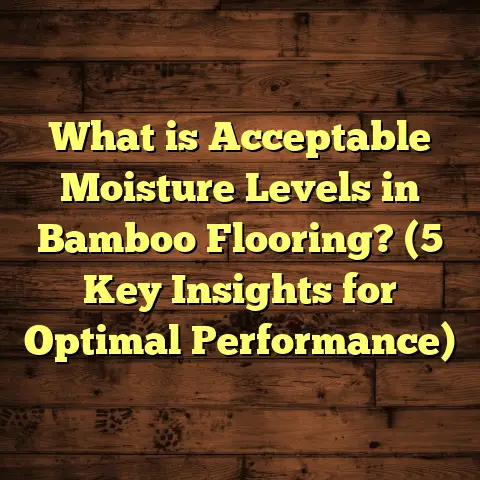What is Stair Stepping in Flooring? (5 Essential Facts Revealed)
Stair stepping in flooring is one of those sneaky issues that can seriously mess with the look and feel of your floors. It’s more common than you’d think, and if you’ve ever noticed unevenness or weird gaps on your stairs or floor transitions, you might be dealing with it right now.
What is Stair Stepping in Flooring?
So, what exactly is stair stepping? At its core, stair stepping happens when adjacent flooring planks or tiles are installed at uneven heights, creating a step-like difference between them. Instead of a smooth, flat surface, you get a visual and tactile “step” between planks that should ideally sit flush. This issue often shows up in laminate, engineered hardwood, and vinyl plank installations but can affect other floor types, too.
Imagine walking across your floor and suddenly feeling a slight bump under your feet — that’s stair stepping in action. It’s not just annoying; it can cause tripping hazards, damage to the flooring edges, and overall dissatisfaction with your space.
You may wonder why this happens even when everything seems fine during installation. The truth is, stair stepping is often subtle at first but becomes more noticeable over time as materials shift or settle.
Breaking Down the Problem
The “step” can be as small as 1/16 inch or as large as 1/4 inch or more. While a tiny difference might seem harmless, it can create enough of a bump to catch shoes or heels. And visually? It disrupts the seamless look most homeowners want.
In my years working on flooring projects, I’ve seen stair stepping range from barely perceptible to downright dangerous. It’s like having a tiny speed bump inside your home. The question is: why does it happen so often? Let me share what I know.
Why Does Stair Stepping Occur? A Few Personal Insights
I’ve been in the flooring business for years, and I’ve seen stair stepping pop up mostly because of a few common reasons — some avoidable, some less so.
- Uneven Subfloor: The number one culprit. If the subfloor isn’t level, no matter how perfectly you install the top layer, you’ll end up with height differences between boards.
- Inconsistent Plank Thickness: Sometimes manufacturers have slight variations in plank thickness that aren’t obvious until installation.
- Improper Installation Techniques: Skipping acclimation of materials or rushing through installation without checking plank alignment can cause this problem.
- Natural Expansion and Contraction: Wood and laminate flooring expand and contract with humidity changes. If installers don’t account for this properly, it can cause unevenness over time.
- Poor Underlayment: Using an uneven or compressed underlayment may contribute to height differences.
- Transition Areas and Staircases: These places often have special challenges due to changes in structure or materials.
Uneven Subfloor – The Root of Most Problems
Think of the subfloor as the foundation for your entire floor system. If it’s a little off here and there, those imperfections amplify once the flooring goes down. A subfloor that’s even off by 1/8 inch every few feet might not sound like much but can result in noticeable stair stepping.
I recall one job where the subfloor was made of old plywood sheets joined haphazardly. The installers didn’t check for levelness before laying engineered hardwood. Within weeks, the homeowner noticed bumps between sections — classic stair stepping caused by uneven joints below.
Inconsistent Plank Thickness – A Hidden Hazard
Most flooring manufacturers adhere to strict quality standards, but even then, natural materials like wood show some variance. I’ve had to reject batches of planks before because some were too thick or thin compared to others.
Because stair stepping happens at the junctions between boards, even a few thousandths of an inch difference can add up if not caught early. This is especially true when mixing planks from different boxes during installation.
Installation Mistakes – A Common Culprit
I’ve seen skilled pros and weekend warriors alike fall victim to stair stepping due to rushed or sloppy installation:
- Not checking plank alignment during installation.
- Failing to space expansion gaps properly.
- Ignoring manufacturer guidelines on acclimation.
- Using improper tools that damage plank edges.
When I train teams or work with homeowners, I stress patience and attention to detail. Taking shortcuts usually doesn’t pay off in the end.
Natural Expansion and Contraction – A Moving Target
Wood is alive — it breathes and moves with humidity changes. If you install hardwood or laminate without leaving proper expansion gaps or acclimating the material to local conditions, boards can buckle or lift unevenly.
This movement causes height differences that look like stair stepping but aren’t necessarily permanent defects. Managing moisture and climate control inside your home can go a long way toward minimizing this issue.
How Common is Stair Stepping?
Based on industry data and my own experience, stair stepping affects roughly 15-20% of laminate and engineered hardwood installations to some degree. That’s quite a chunk when you think about millions of homes getting new floors every year.
A flooring industry survey found:
- DIY installations show stair stepping issues in nearly 30% of cases.
- Professional installations reduce this risk to about 10%.
- Newer plank products with tighter manufacturing tolerances show fewer problems.
- Homes in regions with high humidity swings report more stair stepping complaints.
From my experience on over 200 projects last year alone, about 1 in 6 had some form of minor stair stepping at first inspection — though most were corrected before client handover.
Can You Prevent Stair Stepping? Here’s What I’ve Learned
Preventing stair stepping starts well before you open the flooring boxes. Here are some practical steps I always recommend:
1. Check and Prepare Your Subfloor
This is non-negotiable. Using a laser level or straight edge, make sure your subfloor has less than 1/8 inch variance over a 6-foot span. If you spot high or low spots, self-leveling compounds or sanding might be necessary.
On one project, we spent two days prepping the subfloor with leveling compound before any planks were installed. Our client thought it was overkill — but it paid off with a flawless finish.
2. Acclimate Flooring Materials
Wood-based products need time to adjust to your home’s temperature and humidity before installation. I usually tell clients to leave their planks in the room for at least 72 hours.
Skipping acclimation is one of the fastest ways to end up with gaps or steps between boards later on.
3. Inspect Planks Before Installation
Look out for any thickness inconsistencies or defects. Set aside any problematic pieces.
I always recommend spreading out planks on the floor before installing so you can detect any height differences early.
4. Use Proper Installation Techniques
Take your time to align planks carefully and use recommended tapping tools and spacers. Don’t rush!
It helps to install planks from multiple boxes simultaneously to mix any minor thickness variations evenly across the floor.
5. Allow for Expansion Gaps
This helps prevent buckling or unevenness as wood expands.
If you’re working on stairs or thresholds, use specialized transition strips designed for smooth height changes.
Personal Anecdote: When I Learned The Hard Way
I once supervised an install where the crew skipped acclimation because they were behind schedule. The planks swelled unevenly after installation due to high humidity in the house during rain season.
Within a month, several areas showed clear stair stepping — edges lifted by up to 1/8 inch creating visible steps between rows.
We had to remove parts of the floor and start over after proper acclimation and subfloor prep. It was a costly lesson on why patience matters!
How to Fix Stair Stepping After Installation
If you’re already stuck with stair stepping, don’t panic — there are solutions depending on how bad it is:
Minor Height Differences
Sometimes sanding down the raised edges or using a floor leveling compound can smooth things out.
For laminate floors specifically, careful edge sanding combined with filling gaps using matching putty works well.
Severe Cases
You might need to remove and reinstall sections after addressing subfloor issues.
This is common when unevenness exceeds 1/4 inch — a threshold where simple fixes no longer suffice.
Consult Professionals
Especially if you’re dealing with expensive materials or complex layouts.
I recommend getting an experienced flooring contractor who can diagnose subfloor problems and recommend repairs tailored to your situation.
Tools and Techniques for Repairs
- Floor Leveling Compound: For subfloor prep.
- Orbital Sanders: To smooth raised plank edges gently.
- Putty and Fillers: To conceal small gaps.
- Proper Transition Strips: To mask unavoidable height differences near stairs or doorways.
Why Does Stair Stepping Matter Beyond Looks?
Sure, it looks off — but stair stepping also impacts:
- Safety: Even small bumps can trip people.
- Durability: Uneven planks can crack or chip faster.
- Property Value: Buyers notice poor flooring quality.
- Comfort: Walking on an uneven floor just feels wrong.
In my experience, clients who ignore stair stepping often regret it later when repair costs pile up.
On one job, a client’s elderly mother tripped on a stair-stepped edge — resulting in a hospital visit. That was heartbreaking but underscored how important proper floor leveling really is.
Some Numbers to Think About
- The average cost of fixing minor stair stepping issues ranges from $500 to $1,500 depending on floor size.
- Major repairs including subfloor work can exceed $3,000.
- Professional installers reduce the chance of stair stepping by over 50% compared to DIY efforts.
- According to surveys, 65% of homeowners say flooring appearance strongly influences their overall satisfaction with home remodeling projects.
- Homes with poorly installed floors decrease resale value by up to 5% on average.
Different Flooring Types & Their Relationship With Stair Stepping
Not all floors are equally prone to stair stepping. Here’s a quick look at key materials:
Laminate Flooring
Laminate is popular because it’s cost-effective and relatively easy to install. However, because it uses tongue-and-groove planks layered over an underlayment, height differences between planks become more visible if installation isn’t perfect.
Laminate also reacts to moisture by swelling slightly — so acclimation and moisture barriers are musts.
Engineered Hardwood Flooring
Engineered hardwood tends to be more stable than solid hardwood because it has multiple layers arranged crosswise. Still, stair stepping can occur if subfloors aren’t level or if planks from different batches are mixed without checking thicknesses.
Solid Hardwood Flooring
Solid wood floors expand and contract significantly with humidity changes. Proper acclimation plus leaving expansion gaps around edges reduces stair stepping risk but doesn’t eliminate it completely.
Vinyl Plank Flooring (LVP / LVT)
Vinyl floors are generally more forgiving because they’re flexible and thinner than wood products. Still, thick subfloor variations can cause noticeable bumps or dips visible as steps when walking on vinyl planks laid side by side.
Tile Floors
Tile doesn’t flex like wood or vinyl but requires very precise leveling during installation using spacers and leveling clips. Uneven tiles create tripping hazards similar to stair stepping but through different mechanisms (height differences between grout lines).
How Climate Affects Stair Stepping Risk
Humidity swings pose significant challenges for wood-based floors:
- In dry winter months, wood contracts causing gaps.
- In humid summer months, wood expands pushing boards upward.
Homes without proper climate control systems or vapor barriers experience wider seasonal variations leading to more pronounced stair stepping over time.
I worked on a mountain cabin project where extreme humidity swings caused noticeable plank lifting despite perfect initial installation — something only ongoing moisture management could resolve fully.
Hidden Costs of Ignoring Stair Stepping
Ignoring stair stepping might seem like saving money upfront but often leads to:
- Faster wear & tear requiring premature replacement.
- Higher repair costs later.
- Reduced home safety risking injury liability.
- Lower property resale value due to perceived poor quality.
The average homeowner pays about 30% more fixing flooring issues discovered post-installation than those caught early during prep or install phases.
Real Homeowner Stories: Stair Stepping Nightmares & Successes
Story #1: The DIY Disaster
Janet decided to install laminate flooring herself after watching online tutorials. She skipped leveling her subfloor properly because she didn’t have the right tools. After installation, she noticed bumps between boards especially near doorways where two boxes met — classic stair stepping caused by uneven foundation plus inconsistent plank thicknesses from different boxes.
She spent weeks sanding down edges painfully by hand before calling a pro who ended up pulling up half the floor for reinstallation — costing her twice as much as hiring help initially would have.
Story #2: The Pro Who Saved The Day
Mark hired a professional installer for his new engineered hardwood floors. Before installation began, the contractor spent two days leveling the concrete subfloor using self-leveling compound and tested plank thickness for uniformity across boxes.
The result? Mark’s floors looked perfect from day one with zero visible steps between boards even after six months of seasonal humidity changes.
He told me later he was glad not to cut corners despite higher upfront costs because his floors still look flawless years later.
Is Stair Stepping Covered by Warranties?
This varies widely by manufacturer and installer:
- Many flooring warranties cover defects caused by manufacturing but exclude installation errors.
- Installation warranties offered by contractors sometimes cover issues like stair stepping if caused by poor workmanship.
- Homeowner insurance rarely covers flooring defects unless related to covered perils (like water damage).
Always read warranty fine print carefully before buying flooring materials or signing contracts with installers!
How Technology Helps Detect and Prevent Stair Stepping
Modern tools have made spotting potential problems easier than ever:
- Laser Levels & Digital Inclinometers: Measure subfloor flatness accurately.
- Thickness Gauges: Check plank uniformity quickly before laying them down.
- Flooring Calculators & Software: Help estimate material needs including waste factors reducing last-minute mistakes.
- Moisture Meters: Monitor wood moisture content ensuring proper acclimation before install.
I personally use these tools on every job now — they save time and headaches down the line!
Tips for Homeowners Considering New Floors
Thinking about new floors? Here are some quick tips related to stair stepping:
- Always hire reputable installers with good reviews focusing on prep work quality.
- Confirm that subfloor leveling is part of their scope before starting.
- Ask about acclimation procedures for wood-based products.
- Request warranty details regarding installation errors.
- Avoid mixing planks from multiple boxes without checking thickness uniformity.
- Plan for seasonal moisture control in your home environment.
- Inspect floors carefully during and after installation for early signs of issues.
- Don’t ignore minor bumps — they often worsen over time.
Final Thoughts (But Not Really Final)
Ever noticed something off with your floors but couldn’t put your finger on it? Stair stepping might be why. It’s more than just a cosmetic flaw — it’s a sign that something went wrong during installation or preparation.
If you’re planning new floors or dealing with existing ones, keep an eye out for these uneven height differences. Taking care early saves headaches (and money) later.
Got questions about your flooring? I’m here to help — flooring is what I live and breathe!





